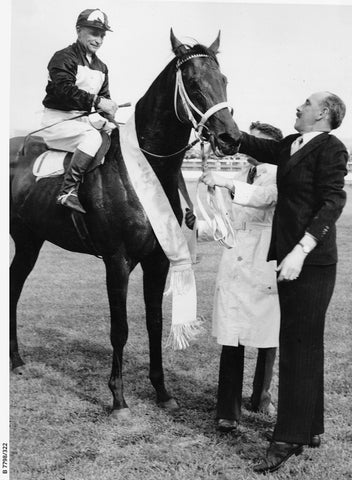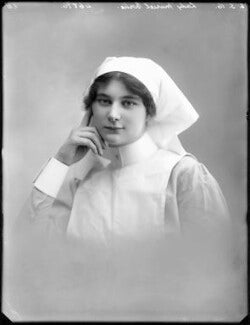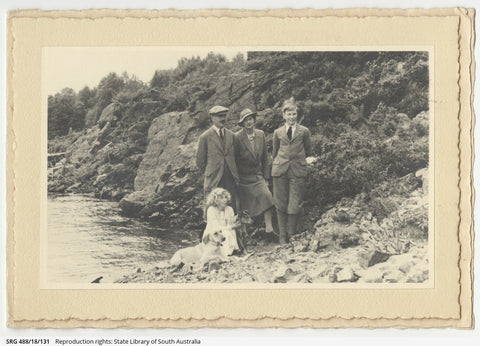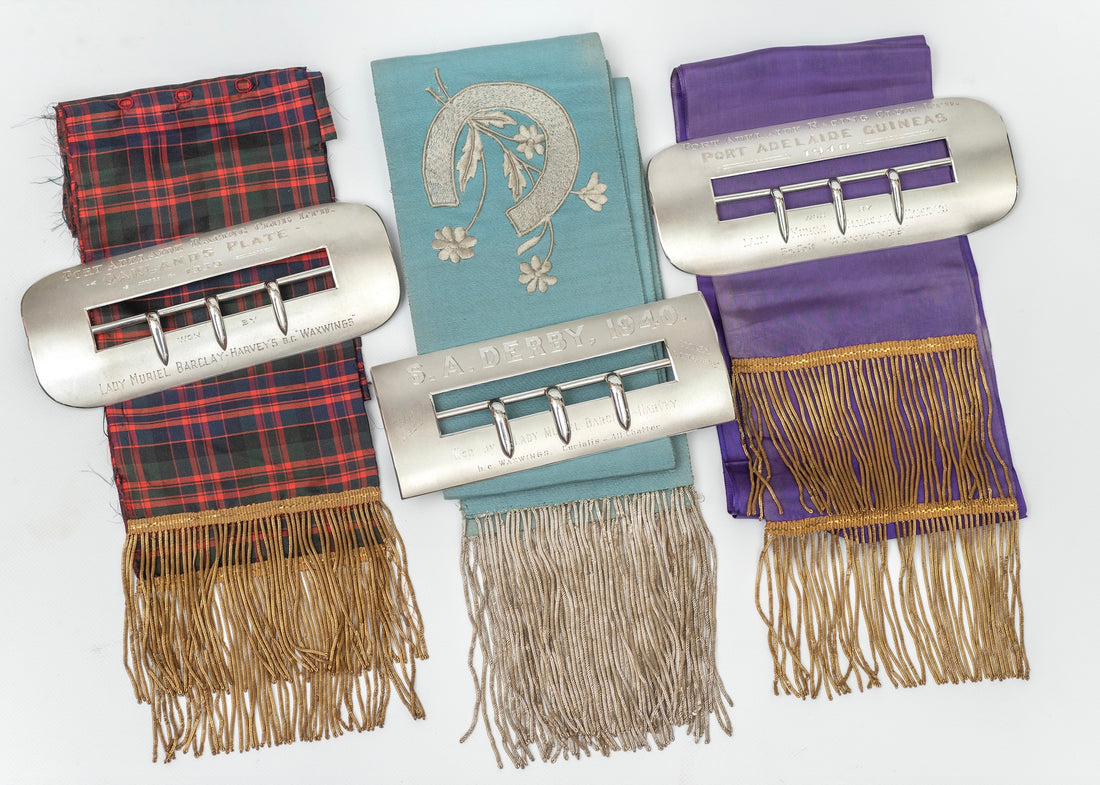This article first appeared in the Summer 2022 issue of Antiques to Vintage Magazine. Written by Elizabeth Cheung and edited by Julie Cooper.
When Sydney dealer Billy Robertson came across a collectIon of three Australian-made sterling silver horse buckles and their respective sashes, he had an idea they represented a remarkable piece of history. With a bit of diggIng, Billy and his Social Media Director and research partner, Elizabeth, uncovered a story of hard work and triumph.

Australian-made horse racing sterling silver buckles and sashes won by Waxwings c.1939-40 and owned by Lady Muriel Barclay-Harvey, the Governor’s wife of South Australia from 1939 to 1944. From left to right: Port Adelaide Oaklands Plate (1939), Waxwings’ historic SA Derby win (1940) and the Port Adelaide Guineas Cup (1940). Maker’s mark on centre buckle for CW Ottoway & Co. Total buckle weight of 950g. Excellent near antique condition and an important piece of Australian and horse racing history, $30,000 AUD.
Dating from 1939-1940, these buckled sashes belonged to Lady Muriel Barclay-Harvey, who was the wife of Sir Charles Malcolm Barclay- Harvey, South Australia’s governor from 1939 to 1944. They also represent a window of time when Australia enjoyed a brief moment of normality before the harsh reality of wartime set in.
The date was October 5, 1940. The South Australian Derby was just about to begin. Waxwings, a spirited 3-year-old colt, was a strong contender. He had delivered promising results during practice and in earlier races; a newspaper had noted earlier in the week that his times were among the best the race had seen. The youngster was a crowd favourite and his owner, Lady Muriel, would surely have been excited. And indeed Waxwings, fresh off winning the Port Adelaide Guineas Cup the month before, was in the best condition of his life. Setting a new record, he won the race in exhilarating fashion, finishing five full lengths ahead of the competition. With his win, Lady Muriel became the first Governor’s wife ever to have won a Derby in Australia, as well as only the second woman owner ever to have won the South Australian Derby.

Waxwings after his record-breaking win at the South Australian Derby in 1940, with jockey R. Medhurst. Image: State Library of South Australia. ‘Mick’ Medhurst holds the record as the most successful jockey in the SA Derby, with five wins: 1937 Golden Hill – 1938 Tempest – 1940 Waxwings – 1941 Lamond – 1951 Beau Cavalier.
The daughter of the 12th Earl of Lindsey, Lady Muriel was by all accounts an avid equestrienne. Not for her were the leisurely rides of many ladies of the time; she actively enjoyed riding as well as hunting and had two successful steeplechasers. Even more impressively, she had won the championship at Richmond Horse Show, England’s principal horse show, for the best lady’s hack (carriage). Married to Captain H.H. Liddell-Grainger in 1922, Lady Muriel had two children, David and Rosemary, before she was widowed in 1935. She married Sir Charles Malcolm Barclay-Harvey in the crypt chapel of St Stephen in Westminster in 1938 and the couple arrived in Australia along with Lady Muriel’s children in August 1939. By 1940, having spent over a year in Australia, Lady Muriel would have been familiar with the race ground at Morphettville; she had visited the track late in 1939 and was the first woman to have viewed a race from the steward’s car. Small wonder that upon having arrived and taken office, it took Lady Muriel less than a week to decide upon and purchase Waxwings.

Lady Muriel Felicia Vere Barclay- Harvey (née Bertie) by Bassano Ltd, Old Bond Street, London. Whole- plate glass negative, 6 May 1916.
Her principal trainer was Ike Reid. At first glance this might have seemed an unlikely choice. Having made his way from being a cattle drover to become one of South Australia’s leading trainers, Ike Reid at one point would scarcely have dreamed of being known to Adelaide’s well-heeled. Yet by November 1939, there was no shortage of female racing owners who trusted him with their horses. Newspapers at the time commented not only on the unusually high number of women owners, but also their excellent racing record; every horse still in active training had won at least one race. Moreover, there was a remarkably friendly atmosphere where the ladies would congratulate each other on wins and take an active interest in each other’s horses. Lady Muriel’s choice was Adelaide society’s final seal of approval, marking Reid as one of Australia’s most fascinating rags to riches stories. It was predicted by many that her arrival would spark increased interest among women to join the sport of racing, which had for so long been restricted to men only.
This progressiveness was to be seen throughout Lady Muriel’s sojourn in Australia and became her hallmark. In an interview shortly after her arrival, she referenced her domestic hobbies and the sporting pursuits she so enjoyed, but also her work during the Great War as a nurse and as a Red Cross ambulance driver at the front. Her words would be prophetic, for even on that beautiful spring day as the crowds at Morphettville cheered and celebrated Waxwings’ Derby win, underneath it all there must have lurked a lingering disquiet. War was imminent and everyone knew it. Scant weeks later, Hitler invaded Poland and Australia too would heed England’s call and join the fight.
There were Australians at Dunkirk, throughout the Western Front and later in WWII; their role in the Pacific was vital. But perhaps the most crucial effort, particularly in the first gruelling years of World War II, came from the home front. As cities in France fell and Paris surrendered, and even London at times seemed to be on the brink of collapse, Britain’s colonies rallied with war bonds, Red Cross drives and more.
It was in this latter role that Lady Muriel rose to the occasion with her signature grace. Having been involved with the Girl Guides as a Divisional Commissioner in Berwickshire since 1922, her experience was vital. The Barclay-Harveys planned and undertook a trip across the Eyre peninsula that was at the time the most exhaustive ever undertaken by a vice-regal couple. Lady Muriel rallied women across South Australia into leading the country in fundraising efforts; in 1943 South Australia’s 581 branches raised £208,287 for the general funds and £16,726 for the Prisoners of War Fund. Presiding over the Red Cross Society at Government House in Adelaide, she oversaw the disbursing of funds and supplies, the organising of volunteers and more. At times when her husband fell ill, she took on his social duties as well.
Upon the opening of the Pacific Theatre, Australia’s role in WWII rapidly expanded; its relative proximity to the Pacific front meant that its manufacturing capabilities were now more necessary than ever before. Adelaide was already an industrial centre, but its manufacturing of munitions and its shipyards would become crucial to the Allies’ efforts in the Pacific. In 1941, among her many duties, Lady Muriel launched HMAS Whyalla, the first ship to be built in the Whyalla shipyard. She would return several times and by 1943 had travelled thousands of miles through South Australia, visiting every single Red Cross branch in the state.
Small wonder that by 1943 both Governor and Lady Barclay-Harvey’s health was failing. It was becoming clear that the rigours of wartime were proving too much for the Barclay-Harveys, who had already given so much.

Sir Malcolm and Lady Muriel Barclay-Harvey with children David and Rosemary and the family dogs, 1944. Image: State Library of South Australia.
On October 8, 1943 Sir Malcolm Barclay-Harvey collapsed and had to be rushed from Ceduna to Adelaide by plane. The writing was on the wall, and on January 21 1944 the Governor announced his impending retirement, which was finalised on April 26 the same year. The Barclay-Harveys, exhausted from their wartime duties, would slowly return to England; first to London, where the Governor would have an audience with the King, then home to the country estate of Aberdeenshire. Lady Muriel’s legacy would include not only her untiring efforts for the South Australian Red Cross and the many hospitals and bases she visited, but also the Lady Muriel Club for nurses of all fighting services and members of the Australian Army Women's Medical Service. She would regard the latter as her proudest achievement.
In the meantime, what of Waxwings, her beloved horse? Unfortunately, a bad injury in the New Year’s Gift of 1942 halted the colt’s racing career for some time. During WWII, a ban on horse-racing was imposed by the South Australian state government; no race meetings were held between March 1942 and August 1943.
Lady Muriel would be parted from Waxwings for most of her vice-regal career, but he never left her thoughts. In 1946, his old trainer Ike Reid told newspapers that the Derby winner was enjoying retirement, “An open-air life of green pastures and contentment at Buckland Park.” Lady Muriel “would not part with her Derby winner for worlds.” Having gone through triumphs and disasters, not to mention a war, both horse and illustrious owner deserve their place in Australian history.

